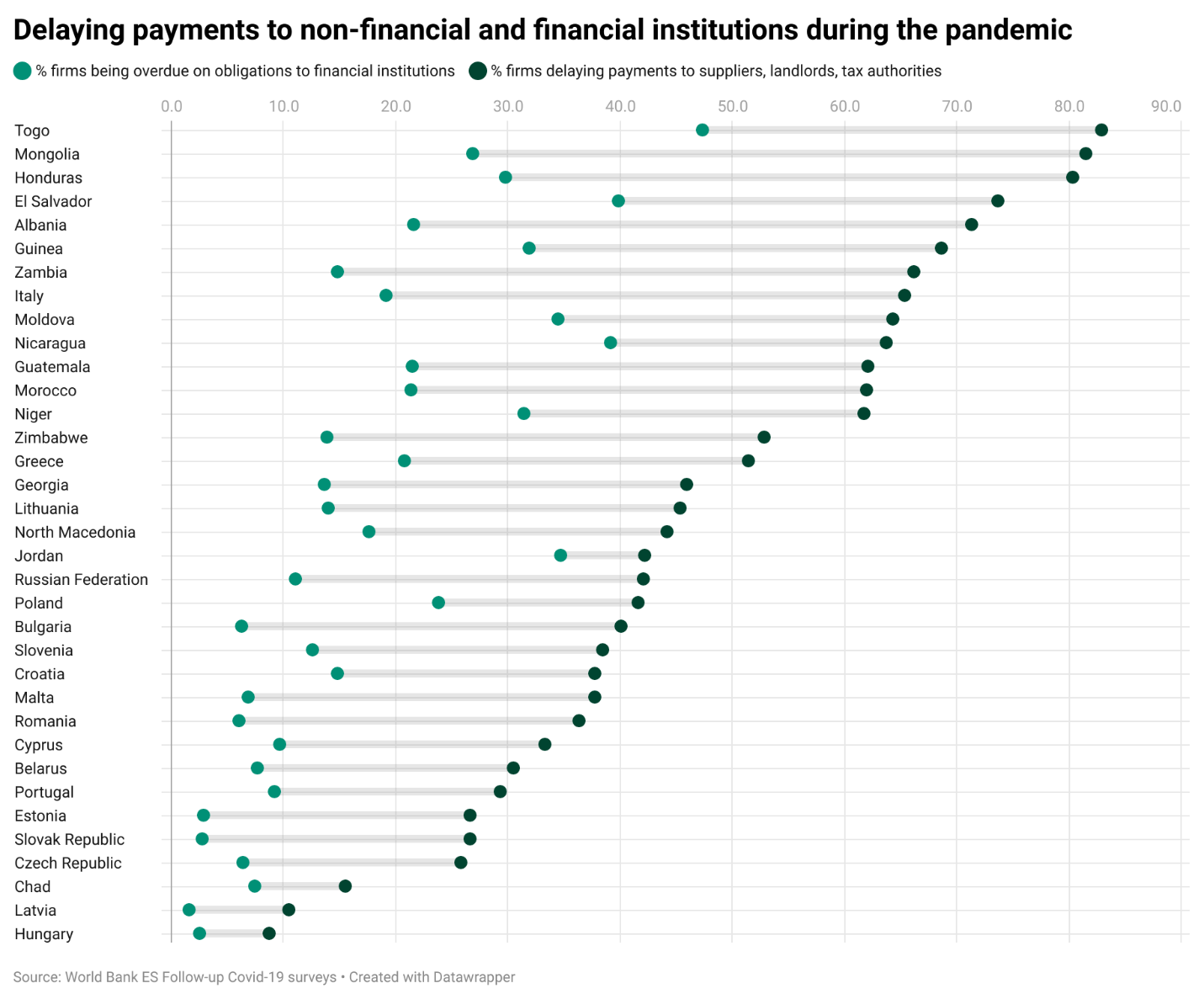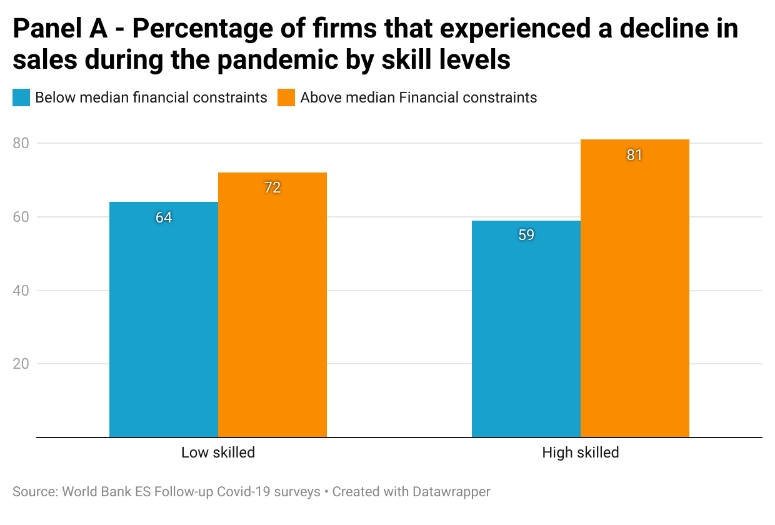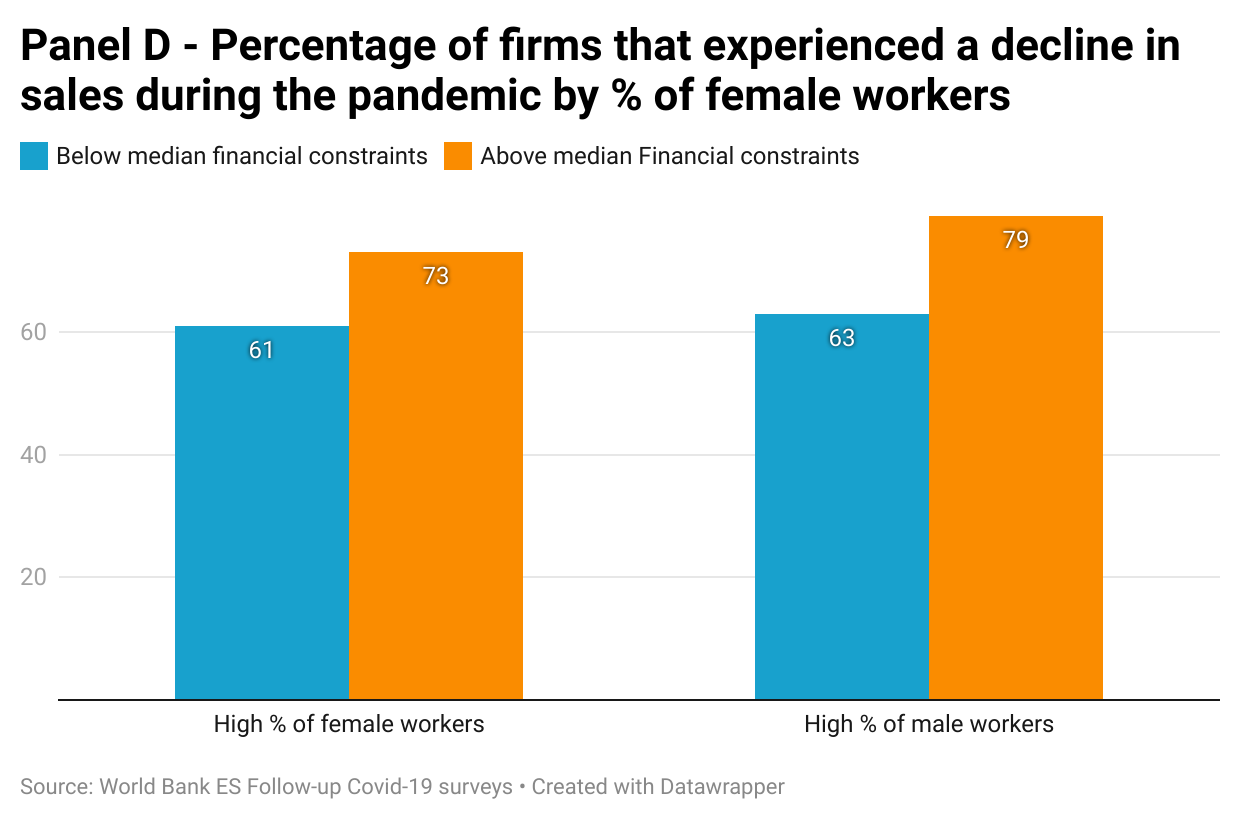The COVID-19 pandemic has led to a sharp disruption of economic activity across the globe. Lockdowns and social distancing measures implemented by governments to limit the spread of the virus have forced many firms to cut production or shut down. While the pandemic may seem to have left no one unaffected, some have been affected more than others. In the private sector, although most firms suffered, some were not impacted at all, and among firms that were adversely affected, the extent of suffering varies sharply. This heterogeneity is confirmed in several studies. For instance, a study by Kozeniauskas et al. (2020) on Portuguese firms finds that while most firms experienced declines in sales, high productivity firms were more likely to remain open, less likely to cut employment, and made less use of government support. Another study by Muzi et al. (2021) uses Enterprise Surveys data for 31 countries and finds that COVID-19-induced exits of firms were fewer among more productive and older firms. Yet another study by Dai et al. (2021) shows that in China, the adverse effect of the pandemic was much smaller on firms located in heavy industrial cluster zones.
While these and other such findings in the literature are important, they may not provide a complete picture of what enabled some firms to ride out the pandemic with less damage than others. Many factors impact firm performance and some may play a more important role than others in influencing a company’s resilience to the effects of the pandemic. For instance, access to finance, which was viewed as one of the biggest obstacles to firm growth in pre-pandemic times in the developing world, may be one such element. Evidence from a series of interviews conducted by the World Bank to measure the impact of the pandemic on the private sector suggests that the share of firms with overdue payments to financial and non-financial institutions, including suppliers, landlords, or tax-authorities, is worrisomely high, in line with the idea that many firms are facing a liquidity crunch due to the pandemic.
This would be expected, as corporate revenues have plummeted, cash flows dwindled, and working capital has been depleted due to the pandemic. External sources of finance such as banks and private investors have also been restricted due to heightened uncertainty, lower profit margins, and difficulty in assessing firms’ effectiveness in dealing with the crisis. Several studies confirm the liquidity crunch, such as Button et al. (2020) for mid-size and large publicly listed companies in the United Kingdom, and Bircan et al. (2020) for small and medium-sized enterprises in 19 mostly emerging economies. Besides, there are indications from earlier crises that liquidity is likely to play an important role in company health. So, what role does access to finance play in helping firms endure the ongoing pandemic?
In our recent study, Amin and Viganola (2021), we attempt to answer this question in a formal and rigorous way. We combine information collected by World Bank Enterprise Surveys on firm financial conditions in the period just before the pandemic and performance after the onset of the crisis. The results show a strong connection between access to finance and survival: firms with better access to finance in the pre-pandemic period were much less likely to experience a decline in sales during the pandemic. According to one estimate, the probability of a sales decline during the pandemic for a firm with the best access to finance was lower by 25.2 percentage points than a firm with the poorest access to finance; and the corresponding percentage decline in sales is smaller by 14.3 percentage points.
We pay close attention to endogeneity concerns. In simple terms, this means that we check that causality runs in the right direction (from finance to firm performance) and that our access-to-finance variable is not simply proxying for other factors. For instance, we test for several sensible predictions about the factors that magnify or mitigate the impact of access to finance on the decline in sales during the pandemic. These predictions are specific to the way access to finance works and so there is no evident reason why the predictions should hold if our finance variable is simply proxying for other factors. The predictions tested also are important by themselves as they reveal substantial heterogeneity in the impact of access to finance. What are these predictions and heterogeneities? First, we predict that access to finance is helpful in fighting the economic effects of the pandemic more for firms that have a stronger long-standing relationship with important stakeholders such as skilled workers and inputs suppliers. This makes intuitive sense: finding skilled workers or training them is costly and time-consuming. Similarly, finding a reliable and trustworthy inputs supplier is not easy, especially in countries where enforcement of contracts is weak.
Note: All groups shown are based on median values of the variable. The skill level of workers in Panel A is proxied by the average wage rate paid by the firm.
Thus, it is no surprise that we find that firms have a greater incentive to use available finance to avoid production cuts when they have more skilled than unskilled workers (Panel A) and when the cost of enforcing new contracts is relatively high (Panel B).
Note: All groups shown are based on median values of the variable. The cost of enforcing contracts in Panel B is as measured by Doing Business, World Bank.
Second, along the same lines as the previous result, we find that the incentives to use available finance to avoid production cuts are greater for firms that have many inputs suppliers than for ones with few suppliers (Panel C).
Note: All groups shown are based on median values of the variable. The number of inputs suppliers in Panel C varies by industry and is measured by the Herfindahl index of inputs bought from various industries. It is based on data from Input-Output Use matrix for US in 2000.
Third, we predict that access to finance impacts firms differently depending on the share of female to male workers. The logic here is that, due to school closures and the subsequent collapse of child-care, many women have been forced to quit jobs to take care of family responsibilities. We expect access to finance to help less to retain workers and avoid production cuts when certain categories of workers, in this case women, are unwilling or unable to work. This is indeed what we find. That is, access to finance has a much smaller impact on the incidence of sales decline during the pandemic for firms that use more female relative to male workers (Panel D).
Note: All groups shown are based on median values of the variable.
Of course, other potential factors that may affect how firms deal with the pandemic can be explored. Some of these could include internet availability, the possibility of working remotely, tasks that require teamwork vs. those that can be performed individually, the quality of supplier networks, domestic vs. international markets, management quality, and the organizational structure of the firm in terms of flexibility of operations. This is a fruitful area for future research.








Join the Conversation